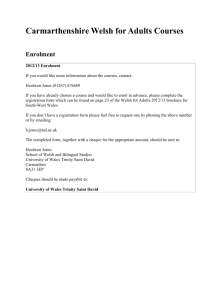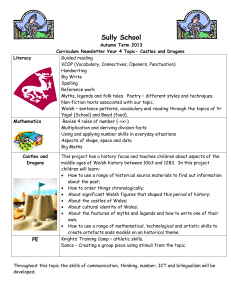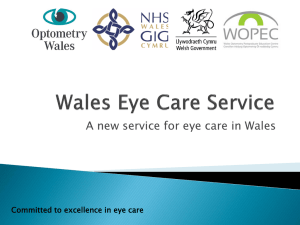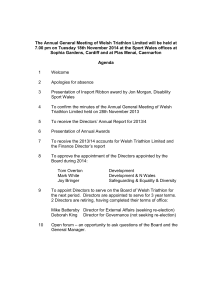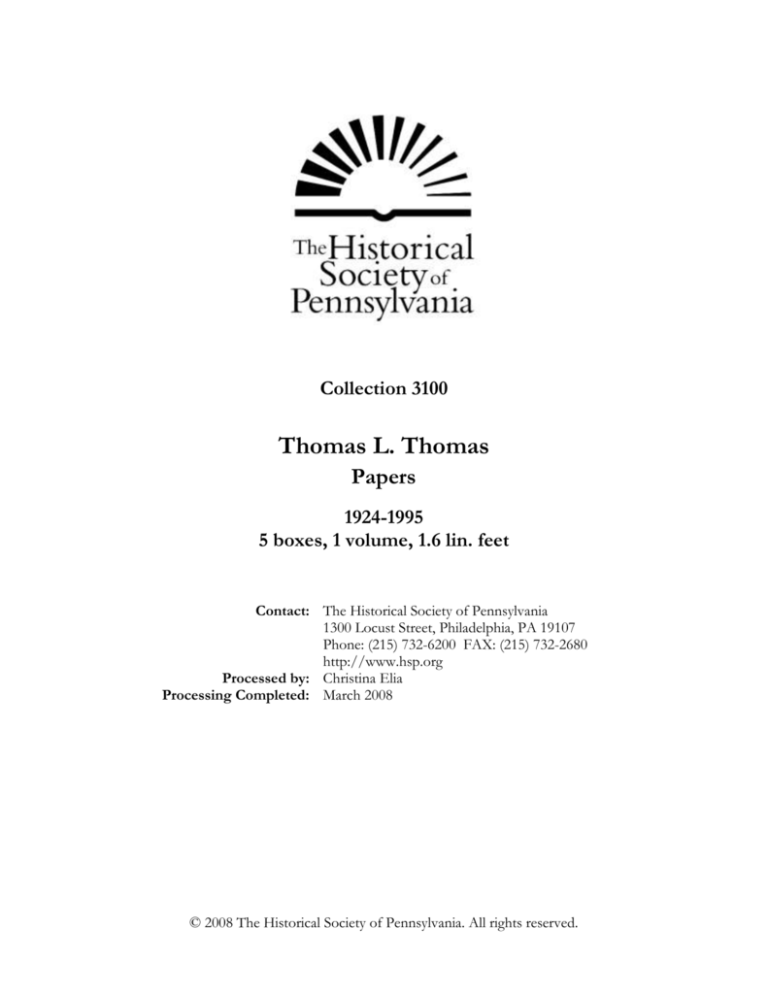
Collection 3100
Thomas L. Thomas
Papers
1924-1995
5 boxes, 1 volume, 1.6 lin. feet
Contact: The Historical Society of Pennsylvania
1300 Locust Street, Philadelphia, PA 19107
Phone: (215) 732-6200 FAX: (215) 732-2680
http://www.hsp.org
Processed by: Christina Elia
Processing Completed: March 2008
© 2008 The Historical Society of Pennsylvania. All rights reserved.
Thomas L. Thomas papers
Collection 3100
Thomas L. Thomas
Papers, 1924-1995 (bulk ca. 1950-ca. 1980)
5 boxes, 1 volume, 0.2 lin. feet
Collection 3100
Abstract
Thomas Llyfnwy Thomas (1911-1983), native of Maesteg, Wales, was an accomplished
baritone who became renowned as “The Voice of Firestone.” After the Thomas family
settled in Scranton, Pennsylvania, Thomas became the youngest and first ever Welshman
to win The New York Metropolitan Opera House’s annual competition. He turned
down a contract at the Met for a life of radio broadcasts, live concert performances,
lectures, and charitable work. At one point, Thomas was considered the highest paid
concert artist in the United States. He retained strong ties with Wales, however,
including a selection of Welsh songs in each performance, being invited to join the
Gorsedd of Bards, and helping launch a Welsh television station.
This small collection features phonograph albums, correspondence, photographs,
clippings, and audio- and videocassettes. The majority of the collection represents
Thomas as an avid enthusiast of music and horses. The inclusion of press kits and
correspondence from professional acquaintances and fans provides further insight into
Thomas’s career.
Background note
Thomas Llyfnwy Thomas (1911-1983) immigrated to the United States from Wales in
1923 at the age of 12. The Thomas family, including father Josiah, mother Mary, older
brother David (“Elwyn”), and younger sister Gwyneth, disembarked at Ellis Island.
Josiah, a notable musician in his own right, arrived with the hopes of a better life for his
family.
The Thomases, like many other Welsh families of the time, settled in Scranton,
Pennsylvania. The appeal of this particular area lay in coal mining, an industry it shared
with Wales. At one time Scranton contained the largest concentration of Welsh outside
of England and Wales, and Pennsylvania was considered “the heart of the Welsh
settlement.”1
Heimlich, Evan, “Welsh Americans,” Thomson Gale, http://www.everyculture.com/multi/Sr-Z/WelshAmericans.html (accessed January 22, 2008).
1
1
The Historical Society of Pennsylvania
Thomas L. Thomas papers
Collection 3100
Growing up in Scranton allowed Thomas to retain not only the heritage, language, and
tradition of the Welsh nation, but also the support and encouragement of a tight-knit
community. His proclivity for music, begun with cantatas at age 5, was encouraged and
enhanced by Josiah’s insistence on practice.
Embracing his new home while remaining faithful to his heritage was a balance Thomas
was able to strike early in his life both personally and professionally. Not only did he
converse in Welsh with brother Elwyn, he also made certain to include traditional Welsh
songs in every concert performance.
After graduating from technical school, Thomas sat poised to become an executive
engineer. This proved to be a turning point in his life as he walked away from the
certainty and predictability of employment in engineering to pursue musicianship full
time.
Recognition came first in 1932 at the Atwater Kent Competition, because of which, as a
finalist, he was presented to President Hoover. Thomas would go on to place 2nd in a
pool of singers that numbered 50,000. Not long after, both Thomas and Elwyn won the
only two scholarships to study singing in New York with Oscar Seagle. The brothers
provided support for one another as the money ran low and the opportunities dried up.
The struggling came to an end in 1937 when Thomas became the youngest singer and
only Welshman to ever win The Metropolitan Opera House’s annual competition. The
prize of $1,000 and a seven-year contract offered financial security and career stability.
Thomas made his operatic debut in May 1937 and his performance was well received.
Again, Thomas opted for a less certain path when he turned down the contract and
lucrative Hollywood offers, believing that the Met was too big a leap for a young
inexperienced singer.
It was with this regard for musicianship that Thomas launched the American Opera
League in 1940. The organization sought to perform opera in English and give
experience and employment to young, struggling singers. This ambitious endeavor
ultimately failed due to insufficient funding.
Failing eye sight prohibited Thomas from enlisting during World War II, but he became
involved as both entertainer and fundraiser. Banding together with other well known
artists such as Joan Fontaine, Thomas held concerts for the troops. By throwing his
name and voice behind the sale of victory bonds, Thomas helped raise a significant
amount of money for the war effort.
Generally, Thomas spent the 1940s and 1950s on the road, performing on two broadcast
shows per week in addition to the sixty live concert performances he gave in the United
States, Wales, Germany, and Australia. At his peak, Thomas was the highest paid
2
The Historical Society of Pennsylvania
Thomas L. Thomas papers
Collection 3100
concert artist in the United States.2 His voice became so closely associated with
Firestone that he became known as the Voice of Firestone.
During this hectic period, Thomas spent his down time relaxing on a 125-acre farm he
purchased in New Jersey. It became a source of great pride as he grew his own
vegetables and raised cows, pigs, and chickens.
The 1960s ushered in some events and choices that would change Thomas’s life.
Thomas married Celia Goshinksi, who he may have met decades earlier. Looking for a
change of scenery, Thomas and Celia settled in Scottsdale, Arizona, and by the end of
the decade Thomas had reduced his schedule to 5-7 concerts a month. International
travel had taken its toll on Thomas and he began to tour domestically in knife and fork
clubs giving lectures that were a mixture of song and story. Knife and fork clubs are
organizations that promote networking and entertain through scheduled dinners which
are accompanied by a lecture or performance.
In 1974, Thomas was reintroduced to listeners when Clyde Gilmour, a Canadian radio
broadcaster, featured Thomas’s music on his program Gilmour’s Album. The broadcast
ushered in a wave of appreciation from fans who sent mail to Thomas directly.
The year 1978 marked an important moment of recognition and pride for Thomas as
Wales’s Gorsedd of Bards selected him for honorary membership to the Bardic Throne.
Individuals in this association represent those “who have made a distinguishable
contribution to the Welsh nation, language, and culture.”3 In an event known as The
Royal National Eisteddfod, members are inducted into one of three orders. As a new
inductee, Thomas was elected to the Ovate Order which requires its members to wear
green robes.
Thomas was invited to participate in the launch of S4C, a Welsh television channel, on
November 1, 1982. He wished the station luck via a live link from his home in Arizona.
On April 17, 1983, Thomas Llyfnwy Thomas died just one month before his native town
of Maesteg, Wales was set to honor him. The ceremony proceeded as scheduled on May
11, 1983, and Thomas’s cousin, Gwyn Bowen, accepted a plaque on his behalf.
Thomas’s remains are buried with his parents in Scranton.
Scope & content
This collection serves as an illuminating and substantial narrative on Thomas’s life. The
items span from 1924 to 1995 and consist of photographs, biographical materials,
professional publicity, and correspondence. Other items include audio-visual materials, a
plaque awarded by his native town of Maesteg, Wales, and a volume given to Thomas in
honor of his performance in H.M.S. Pinafore at twelve years of age. Combined, these
materials represent the professional and personal life of Thomas. Although the
Elfred and Barbara Thomas, “Thomas Llyfnwy Thomas (1911-1983): Portrait of a Professional (Part 2).”
Welsh Music 8, no. 4 (1987): 29.
3 The National Eistedfodd of Wales, “Gorsedd of Bards,”
http://www.eisteddfod.org.uk/english/content.php?nid=43 (accessed January 17, 2008).
2
3
The Historical Society of Pennsylvania
Thomas L. Thomas papers
Collection 3100
collection is detailed, items relating to his early life in Scranton and as a young performer
in New York are not as prolific.
Box 1 contains two phonograph albums, photographs, and clippings that reflect
Thomas’s lifelong love for music and horses. The first folder contains an image of
Thomas as Sir Joseph Porter in a 1924 school production of H.M.S. Pinafore in Wales,
publicity shots from his early and later career, and two photos of sister Gwyneth’s
wedding. The second folder includes a 5 x 7 color photo, two black and white publicity
shots, clippings about performances and appearances, and a song list in Thomas’s own
hand with a note explaining the purpose of such large handwriting. Folders 3 and 4 are
filled with twenty-six black and white photographs of Thomas’s farm in New Jersey.
When Thomas purchased the property, it was in dire need of repair (see the press kit in
Box 2 Folder 1 entitled “Publicity: 1937-1970”) and images document its original state
and remodeled appearance. Other photographs show Thomas posed with vegetables,
cattle, and horses, showing that farm work had become a great source of pride to him.
Folder 5 contains seven 10 ½ x 13 ½ black and white photographs of the barn and
house from various angles and in various states of repair. An 11 x 14 photograph shows
Thomas with what appears to be a mule. A 2 ½ x 3 ½ photograph presents the house in
its original state with two people posed on its porch.
Two phonograph albums are the last pieces in this first box. One entitled Welsh
Traditional Songs (Victor Records) contains an inscription to Celia. The album consists of
four sleeves, one for each disk holding a total of eight songs. The other album, Worship
in Song, was produced to benefit Thomas’s church, The Church of the White Spire. The
album, recorded in 1969, is two sided and contains twelve songs. The sleeve provides
Thomas’s photograph and brief biographical note in addition to a concise history of
religious music. Items related to this album, including thank you notes from U.S.
Senator Paul Fannin and Hillary Rodham Clinton, are in Box 2 Folder 5.
Box 2 contains programs from various concerts and lectures, press kits, itineraries,
scrapbook photos and clippings, and other miscellaneous items. The first folder
contains several original and photocopied programs of Thomas’s performances, the
most notable being a Carnegie Hall program circa 1942; clippings, such as a photocopied
review from The New York Times of a 1941 performance in Cyrano; scripts from several
Victory Loan Hour programs; photographs including an 8 ½ x 11 black and white of
Thomas with Maxine Stellman, Edward Johnson, and a general manager of the
Metropolitan Opera House; and a press kit that provides interesting tidbits about
Thomas’s hobbies, farm, and adjustment to America.
Folders 2 and 3 document Thomas’s professional performances as the Voice of
Firestone and various lectures at knife and fork clubs. Items include scripts,
correspondence, programs, and itineraries. The pieces span from the early 1960s to
1976 and reflect Thomas’s lifelong love for music and mission to provide young
musicians with experience and exposure.
4
The Historical Society of Pennsylvania
Thomas L. Thomas papers
Collection 3100
Gilmour’s reintroduction of Thomas’s voice to radio listeners led to an accumulation of
fan correspondence, some of which is included in Folder 6 along with correspondence
between Thomas and Gilmour. Folders 7 and 8 document Thomas’s 1978 induction
into the Gorsedd of Bards with a program and correspondence in Welsh and English
and photographs originally housed in a scrapbook. Fifty-nine color 3 ½ x 4 ½
photographs show Thomas dressed in green robes at the induction and depict family
atherings in Wales and London. Photocopies record how the photographs were
originally presented in the scrapbook.
Folder 9 contains clippings about S4C, an all-Welsh television station. The clippings
mostly represent the period of its launch in 1982 and mainly derive from Welsh
American newspapers.
Folder 10 contains obituaries and clippings memorializing Thomas up to ten years after
his death in April 1983. Folder 11 houses a program and a clipping from an event set to
honor Thomas in May 1983.
Folders 12 and 18 contain remembrances of Thomas including a two-part article
published in Welsh Music in 1986 and 1987 (Folder 12) and correspondence between
Thomas’s cousin Elfred in Wales and Thomas’s wife Celia in Arizona (Folder 18).
Inventories of items donated to a museum (Folder 14), an Ellis Island Official Certificate
of Registration (Folder 13), and miscellaneous clippings regarding Welsh Americans
(Folder 19) round out the collection. Of note are some clippings and correspondence in
Folder 14 related to Dr. Islyn Thomas, founding member of the National Welsh
American Foundation and avid writer and researcher. Correspondence from Hillary
Rodham Clinton expresses her appreciation for information supplied concerning her
Welsh roots.
Folder 16 contains a 12,000-word biography with a family tree tracing Thomas’s
forefathers and male lineage. Comments and additions are written in pen throughout the
biography.
Box 3 contains three videocassettes, two of which are telecasts featuring Thomas on the
Voice of Firestone and the other is entitled Maesteg Man Draw (see Box 2 Folders 14 and
17 for English-language transcript); three audiocassettes, one of a memorial service, one
of BBC radio broadcasts in 1987 featuring his songs, and one that may be of a wedding;
and one open-reel audiotape entitled “TLT Sentimental Journey.”
Box 4 contains the plaque awarded posthumously to Thomas by the citizens of Llynfi
Valley and accepted by cousin Gwyn Bowen. Other items from this event are in Box 2
Folder 11.
Box 5 features poster-size publicity images: two black and white photos of Thomas in
formal wear and one full-color sketch.
5
The Historical Society of Pennsylvania
Thomas L. Thomas papers
Collection 3100
Separation report
None.
Related materials
At HSP:
Hartmann, E.G. Americans from Wales. New York: Octagon, 1978. (E184 .W4 H33
1978)
Jones, W. D. Wales in America: Scranton and the Welsh, 1860-1920. Cardiff:
University of Wales with University of Scranton, 1993. ( E184 .W4 J66x 1993)
Thomas, I. Our Welsh heritage. New York: St. David’s Society, 1972. ( HV3198 .A2
O8x)
British Broadcasting Corporation, South East Wales Maesteg – our guide to life in the
Llynfi Valley, http://www.bbc.co.uk/wales/southeast/sites/maesteg.
The National Library of Wales, http://www.llgc.org.uk.
The National Museum Wales, http://www.museumwales.ac.uk.
The National Welsh American Foundation, http://www.wales-usa.org.
Ninnau Publications, NINNAU & Y Drych, http://www.ninnau.com – The merging of
2 Welsh American newspapers, NINNAU and Y Drych, now known as NINNAU &
Y Drych.
S4C, http://www.s4c.co.uk.
The Welsh Society of Philadelphia, http://www.welsh-society-phila.org. The “oldest
ethnic society in America.”
Bibliography
Heimlich, Evan, “Welsh Americans,” Thomson Gale
http://www.everyculture.com/multi/Sr-Z/Welsh-Americans.html
The National Eistedfodd of Wales, “Gorsedd of Bards,”
http://www.eisteddfod.org.uk/english/content.php?nid=43
6
The Historical Society of Pennsylvania
Thomas L. Thomas papers
Collection 3100
Thomas, Elfred & Barbara. “Thomas Llyfnwy Thomas (1911-1983): Portrait of a
Professional (Part 2).” Welsh Music 8, no. 4 (1987): 29.
Languages represented
English, Welsh.
Subjects
Baritones (Singers) – United States – Welsh Americans
Folk songs, Welsh
Foreign radio stations – Canada - Toronto
Immigrants – Pennsylvania - Scranton
Immigrants – Welsh – United States
Newspapers, Welsh – United States
Opera companies – New York - Auditions
Radio broadcasters - Canada
Radio programs, Musical – New York (state) – New York
Television broadcasting of music – United States
Television stations - Wales
Welsh Americans – Pennsylvania – Scranton
Wales, South
World War, 1939-1945 – War work - Canada
World War, 1939-1945 – War work – United States
Firestone Tire and Rubber Company
Gorsedd of Bards - Membership
Metropolitan Opera (New York, N.Y.)
NBC Television Network
United Church of Christ – Arizona – Phoenix
Royal National Eisteddfod
Gilmour, Clyde, 1912-1997
Thomas, Celia, 1917-1999
Thomas, David Elwyn, 1908-1981
Thomas, Islyn D., 1912-2002
Thomas, Thomas L., 1911-1983
7
The Historical Society of Pennsylvania
Thomas L. Thomas papers
Collection 3100
Administrative Information
Restrictions
The collection is open for research.
Acquisition information
Gift of Celia Thomas, 1997.
Alternative format
None.
Preferred citation
Cite as: [Indicate cited item or series here], Thomas L. Thomas Papers (Collection 3100),
The Historical Society of Pennsylvania.
Processing note
Scrapbook photographs were removed for preservation purposes. The layout of the
scrapbook was captured by photocopying the book in its entirety.
8
The Historical Society of Pennsylvania
Thomas L. Thomas papers
Collection 3100
Box and folder listing
* Folders marked with an asterisk contain material written, printed, or sung in Welsh.
Folder title
Throughout life - Love of music
and horses
Throughout life – Love of music
and horses
Throughout life – Love of music
and horses, photographs
Throughout life – Love of music
and horses, photographs
Throughout life – Love of music
and horses, photographs
Record album, “Welsh
Traditional Songs”*
Record album, “Worship in
Song”
Publicity
Discovering talent and teaching
voice
Informal lecture recitals at dinner
clubs and similar institutions
News clippings
“Worship in Song” for The
Church of the White Spire
Clyde Gilmour, Canadian
broadcaster features Tom’s
records
Royal National Eisteddfod,
scrapbook
Royal National Eisteddfod*
New Welsh TV Channel S4C
Memorial
Plaque
Program and clipping removed
from Box 4
“Welsh Music Cerddoriaeth
Cymru”*
Ellis Island
Islyn Thomas
Miscellaneous clippings
12,000 word background
Maes Teg Man Draw transcript*
Date
1924-ca. 1965, n.d.
Extent
9 items
Box
1
1954-1978, n.d.
13 items
1
2
ca. 1950- ca. 1960
13 items
1
3
ca. 1950- ca. 1960
13 items
1
4
ca. 1950- ca. 1960
9 items
1
5
ca. 1950- ca. 1960
1 item
1
n/a
ca. 1969
1 item
1
n/a
1937-1970, n.d.
1962-1964, n.d.
30 items
18 items
2
2
1
2
1965-1976, n.d.
34 items
2
3
1968-1995, n.d.
1968-1969, 19921993, n.d.
1974-1995, n.d.
7 items
24 items
2
2
4
5
29 items
2
6
1974-1978
82 items
2
7
1978, n.d.
1982-1993, n.d.
1983-1995
1983
1983
7 items
26 items
5 items
1 item
3 items
2
2
2
4
2
8
9
10
n/a
11
1986-1987
2 items
2
12
ca. 1992
1993, n.d.
n.d.
n.d.
n.d.
1 item
8 items
3 items
22 items
1 item
2
2
2
2
2
13
14
15
16
17
9
The Historical Society of Pennsylvania
Folder
1
Thomas L. Thomas papers
Collection 3100
Papers – Celia Thomas
Miscellaneous clippings –United
Kingdom
Thomas L. Thomas Voice of
Firestone telecasts
Thomas L. Thomas Memorial
Service, Audiocasette
Thomas L. Thomas Memorial
Service, CD: Archival & Use
Thomas L. Thomas BBC Radio
Broadcasts, Audiocassette
Thomas L. Thomas BBC Radio
Broadcasts CD: Archival & Use
Maesteg Man Draw*
TLT Sentimental Journey
Unspecified audiocassette, CD:
Archival & Use
Shakespeare’s Complete WorksInscribed to Thomas
Poster Size Publicity; Color
Sketch
Poster Size Publicity; Black and
White
Poster Size Publicity, Black and
White
1985-1992
1986, n.d.
7 items
8 items
2
2
18
19
1949-1951, 1953,
1959
1983
2 items
3
n/a
2 items
3
n/a
1983
1 item
3
n/a
1987
1 item
3
n/a
1987
2 items
3
n/a
n.d.
n.d.
n.d.
1 item
1 item
2 items
3
3
3
n/a
n/a
n/a
n.d.
1 item
n/a
n/a
n.d.
1 item
5
1
1965
1 item
5
2
1965
1 item
5
3
10
The Historical Society of Pennsylvania

